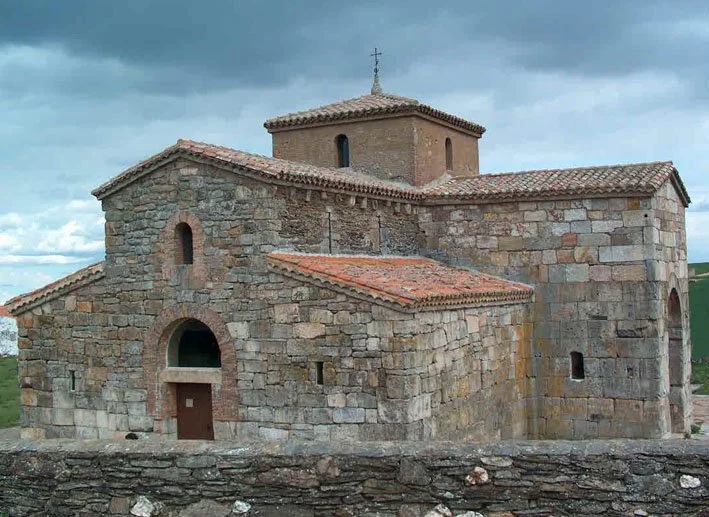A not-quite-exhaustive but definitely exhausting overview of Iberian history
paleolithic
c. 200,000 BP - Neanderthals first enter Iberian Peninsula
c. 70,000 BP - Mousterian Neanderthal culture established
c. 40,000 years ago - anatomically modern humans enter the Peninsula from Southern France
neolithic
c. 5th millenium BCE - Cardium culture extends from East Mediterranean to eastern shore of Peninsula
chalcolithic
c. 3000 BCE - complex cultures arise
c. 2800 - 2700 BCE - Beaker culture originates in present-day Portugal and spreads to Western Europe
bronze age
c. 1800 BCE - Los Millares culture develops; followed by El Argar culture -
bronze metalworking spreads from these centers
Late Bronze Age - Tartessos (urban center) developed in Southwest Iberia
characterized by Phoenician influence
1st millenium BCE - waves of Pre-Celts and Celts migrate from Central Europe -
Peninsula dominated by Indo-European speakers
Castro culture develops in northwestern Iberian (Galicia, Asturias, modern northern Portugal)
iron age/pre-roman iberia
7th century BCE - complex agrarian and urban civilizations
Pre-Celtic or Celtic (Lusitanians, Celtiberians, Gallaeci, Astures, Celtici, etc)
Iberian - east and south
Aquitanian - western Pyrenees
12th century BCE - Phoenician sailors begin exploring the coastline of Peninsula
c. 1100 BCE - Phoenician merchants establish trading colony of Gadir (modern day Cádiz)
c. 800 BCE - Gadir becomes permanent port for silver exports
8th century BCE - first Greek colonies founded on eastern Mediterranean coast
Phoenicia retained control over south coast
6th century BCE - Carthaginians arrive in the Peninsula
roman hispania
218 BCE - first Roman troops occupy Iberian Peninsula during the Second Punic War
181 - 133 BCE - Celtiberian Wars fought between advancing Roman Empire and Celtiberian tribes of Hispania Citerior
19 BCE - Caesar Augustus annexes the Iberian Peninsula
Province of Hispania
divided into Hispania Ulterior and Hispania Citerior during late Republic
further divided into Hispania Tarraconensis (northeast), Hispania Baetica (south), and Lusitania (southwest)
306 CE - Council of Elvira held by Hispanic bishops
5th century CE - Western Roman Empire falls; parts of Hispania come under Germanic control
Roman culture in iberia
Major Cities:
Zaragoza (Caesaraugusta)
Tarragona (Tarraco)
Mérida (Augusta Emerita)
Valencia (Valentia)
León (Legio Septima)
Badajoz (Pax Augusta)
Palencia
Historical Figures:
Emperor Trajan
Emperor Hadrian
Emperor Theodosius I
Seneca
Martial
Quintillian
Lucan
gothic hispania (5th - 8th centuries)
5th century - first Germanic tribes invade Peninsula
Visigoths - Visigothic Kingdom in Toledo
Suebi - Suebi Kingdom in Gallaecia
Alans
Vandals - Kingdom of Vandalusia (Andalusia)
410 CE - Sack of Rome
415 CE - Romanized Visigoths enter Peninsula
418 CE - Visigothic Kingdom established on Peninsula
585 CE - Suebic Kingdom annexed
589 CE - Third Council of Toledo
King Reccared accepts Catholic faith
Visigoths reject Arianism in favor of Catholicism
624 CE - conquest of Byzantine Spania
654 CE - Visigothic Code completed
unified code of law for both Gothic and Hispano-Romans
will become foundation for Spanish legal system through the 13th century
711 CE - Battle of Guadalete
Umayyad conquest of Toledo
the visigothic kings
415–418 Wallia
418–451 Theodoric I
466–484 Euric
484–507 Alaric II
511–526 Theodoric the Great
568–586 Liuvigild
586–601 Reccared
612–621 Sisebut
621–631 Swintila
649–672 Recceswinth
694–710 Wittiza
710–711 Roderic
714 – c. 721 Ardo
visigothic architecture
San Pedro del la Nave
Basilical Churches:
San Pedro del la Nave (El Campillo)
Santa María de Melque (San Martín de Montalbán)
Santa Lucía del Trampal (Alcuéscar)
Santa Comba (Bande)
Santa María de Lara (Quintanilla de las Viñas)
Visigothic Crypt of Saint Antolín - Palencia Cathedral
built to preserve the remains of Saint Antoninus of Pamiers
Reccopolis:
only city in Western Europe founded between the 5th and 8th centuries
one of four (possibly more) cities founded in Hispania by the Visigoths
construction ordered by King Liuvigild to honor his son Reccared
Served as Reccared’s seat as co-king in the province of Celtiberia (west of Carpetania)

